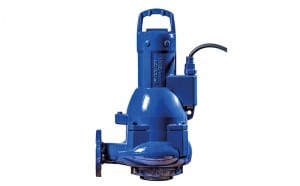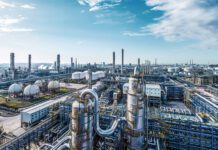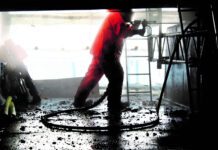AGAINST a background of growing demand from the water and wastewater treatment industries for submersible motor pumps that resist clogging, deliver reliability and contribute to improving energy efficiency, KSB AG has developed a new centrifugal pump, the Amarex-KRT F-Max (pictured) that addresses these issues.

Improved hydraulic system and motor performance are delivered through the design of a new vortex impeller and a motor that offers efficiencies currently calculated according to the same IEC 60034-2 measurement method as that used for motors of dry-installed pumps.
In order to attain a pump’s optimum operating point, it is essential to select the correct impeller and size of impeller for the application. Whilst free-flow or ‘open’ impellers enable suspended solids in wastewater to pass more easily through the pump than closed single channel or multi-channel impellers, they do not compare favourably when it comes to performance. It is for these reasons that KSB has focused on designing an open impeller that can achieve and even exceed the efficiency levels associated with single-channel impellers.
To improve overall efficiency, KSB has looked to optimise the motors’ efficiency in anticipation of future standards and market requirements in compliance with IE3. In this effort, KSB has markedly reduced energy consumption.
Impeller development
The concept behind the design of the new pump is the elimination of clogging, a problem that causes inefficient flows and sometimes even subsequent pump failure. It is caused by the presence of solids in wastewater. According to KSB the first stage in finding a solution to clogging in this case was to differentiate between rigid and non-rigid solids. Michael Lebkuecher, who headed the product management for solid burden pumps, commented: “Rigid solids need to have sufficient space in the pump chamber for them to pass through the pump. When it comes to non-rigid solids we have to ensure that the presence of wet tissues and similar fibrous materials do not form a mass. These problems were resolved, but then the next challenge was to address overall efficiency.”
Fibrous materials, such as hygienic wipes, have become a major problem in waste water transport as their use has markedly increased in the last few years. As a result of the trend towards conserving drinking water and separating stormwater and waste water, the waste water to be handled has become ‘thicker’. This is why operators now demand non-clogging impellers that offer reliable operation without sacrificing high efficiencies, even for small waste water pumps.
KSB’s hydraulic experts employed Computational Fluid Dynamics (CFD) to gain detailed knowledge about the complex flow processes inside the pump via computer-aided simulations. The F-Max Impeller combines outstanding hydraulics efficiency in a vortex impeller with the free passage of rigid and non-rigid solids through the pump.
• A longer version of this article is available on the Envirotec web site (see SLUDGE & WASTEWATER section)






